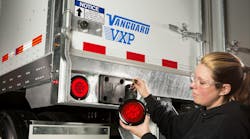Fleet best practices to correct electrical and lighting issues
There is not yet a technology or algorithm capable of tracking down and correcting electrical and lighting issues, and until there is, technicians will have to continue to troubleshoot and correct electrical and lighting problems the old-fashioned way – through the process of elimination. It is still a matter of power and ground.
If a maintenance department already has a well-documented preventive maintenance (PM) protocol in place, they are likely already periodically examining the electrical and lighting system on each vehicle.
A fleet’s drivers are the last line of defense for detecting lighting issues, so it is important to remind drivers that they are required by law to inspect their truck and trailer before starting their shift and again every 24 hours on the road.
Make drivers part of the maintenance team
Before a driver starts a pre-trip inspection, they might be asking themselves a few questions. Did my fleet take the required maintenance and service steps to support proper lighting operation on my vehicle? Did my fleet make educated decisions in selecting or specifying electrical and lighting technology? Did fleet management adequately train me to perform a driver vehicle inspection?
Drivers who know the answers to these questions are indicative of a well-run fleet, and well-trained drivers and maintenance crews work together. Without knowledge, understanding, cooperation, teamwork, and training, even a good maintenance program can be undermined by an uninformed, untrained driver in the field.
While there are not any legal guidelines governing how long a pre-trip inspection should take, a proper inspection will take somewhere between 30 and 50 minutes. Doing an inspection properly requires following a process, focus, and vigilance as the driver moves methodically around each area of the vehicle.
Some critical lighting features that can easily get overlooked are reflectors and conspicuity tape. These passive safeguards are there as a critical precaution and a key feature of safety and visibility. They can also save lives in situations where lighting and power have been lost on a vehicle.
Drivers can receive violations for having defective reflectors and conspicuity tape. Working together, maintenance crews and drivers need to make sure that reflectors are free of cracks and dirt. Be aware that over time, conspicuity tape can also deteriorate so that it is no longer sufficiently reflective, thus making it a candidate for an infraction or, worse yet, a collision.
Over the long haul
It is important for every fleet to establish and adhere to a well-documented PM schedule, including the thorough examination of a vehicle’s entire electrical and lighting system beginning on day one.
If OEMs have positioned wiring and connectors in high-moisture areas, such as just above or behind tires, the fleet maintenance team may want to add ancillary protective coverings in the form of boots, plastic looms, moldings, or tubing.
These measures not only help reduce high-pressure moisture exposure, they also diminish the potential damage that can be inflicted by rocks, road debris, and ice accumulation that can place undue stress on wiring and connection points.
During the new vehicle inspection, maintenance professionals should make sure that all lighting is correctly installed and operational. They should look for wires and cables that are bent sharply and those that come into contact with metal edges, such as where wires pass through walls or into body cavities.
Dielectric grease can be added to grounding ring terminals that are improperly connected to a frame member and might otherwise produce a galvanic response caused by two dissimilar metals making contact.
To the extent possible, corrections should be made and the system augmented as needed. Any wiring that appears to be loosely hanging should be secured. If unused connectors are spotted, these should immediately be capped.
The cable and wiring augmentation described above will help guard against corrosion, but if problems arise, here is what to look for. Wiring and harness problems usually come in three identifiable categories:
- Failure due to a grounded circuit
- Failure due to an open circuit
- Failure due to a short circuit
Once the vehicle is in service, maintenance personnel should focus on seals, connection points, and cable and wiring integrity.
Fleets should follow this five-point approach:
- Start corrosion prevention on the day the fleet takes possession of the vehicle.
- Train drivers to perform proper pre-trip inspections (make them a part of the maintenance protocol).
- Train everyone on the team on how to spot corrosion and where to look for it.
- Stick to a regimented PM schedule.
- Replace incandescent lamps with LED lamps.
By taking some practical steps in the short term and some intelligent steps in the long term, a fleet can ensure their trucks are safe, well-lit, and prepared for whatever they meet on the road ahead.




